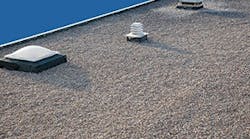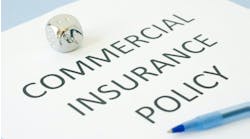Your roof is a landmine of potential hazards. Ladders, perimeter walls, decking, skylights, and physical exposure to the natural elements can put workers at risk for slips and falls.
Your general duty clause extends to your roof so make sure you take the right precautions. Commonsense practices such as limiting who can access the roof, requiring training for those who do, and providing safety equipment will help to keep facilities staff and outside contractors from harm.
Roofing Hazards Overview
Roofs aren’t designed for constant foot traffic yet inspections and repairs require workers to tread lightly across membranes and metal panels. Many roof accidents involve trips or falls from heights that result in hundreds of deaths annually and scores of other non-fatal injuries.
Consider the many risks workers are exposed to while on the roof:
- Ladders – If your building doesn’t have interior stairs and a doorway to the roof, workers must use caution when using ladders. These can become unstable if they aren’t properly secured or tied off to the building, notes Brian Impellizeri, senior product manager with GAF, a roofing manufacturer.
- Exterior Egress – Beyond ladders, staff should exercise situation awareness when accessing the roof via hatches, elevators, penthouse doors, scaffolding, or power equipment such as scissor lifts and aerial work platforms, says Brad Richardson, a certified safety professional and director of environmental health and safety for D. C. Taylor Company, a roofing contractor.
- Skylights – While great for natural light, these fixtures can give way if too much weight is put on them. A worker may accidentally step on them or trip on the edges.
- Parapet Walls – Buildings that have no barrier on the roof ledge pose an immediate risk and others may have walls that are too short to prevent someone from tumbling over.
- Loose Debris – Tree branches, leaves, construction materials, and tools can all pose a tripping hazard. In windy conditions, they may also become flying debris.
- Extreme Heat – A cool roof can be a hot place for workers surrounded by reflected heat. Roofing repairs and renovations are also a tiring activity and technicians are susceptible to something as simple as dehydration when performing tasks for hours under the sun, reminds Impellizeri.
- Slippery Conditions – It can be difficult to maintain footing on steep pitches, ice, snow, moisture, or flat roofs with gravel.
- Electrical – Workers need to be aware of roof tasks that take them near overhead power lines, conduit, solar panels, and HVAC equipment, Richardson notes.
- Chemical Exposure – There’s a high potential that employees might breathe in or touch toxins, such as asbestos or lead, when dealing with roofing materials, he adds. This can include biological materials such as rodent and bird droppings.
- Repetitive Motion Injuries – Roof work involves activities that can cause strain, such as standing for long periods of time, kneeling, lifting, using tools, and climbing ladders.
In addition to keeping contractors safe, you also want to ensure your roof isn’t being abused from careless contact. Even the simple act of strolling across high traffic areas can weaken surfaces.
When service technicians access your roof, their priority is to work on the equipment at hand. If they aren’t thinking about your roof integrity, workers may leave tools or debris from repairs, says Impellizeri. Even accidentally dropping tools can puncture the membrane.
There’s also a possibility that unnecessary holes may be drilled into the roof to install equipment or flashing around penetrations may be forgotten. Down the road, deterioration in these weak spots can pose a tripping hazard, cautions Richardson.
But contractors aren’t the only ones who can cause wear and tear. Your own staff may not be thinking about what’s underfoot and cut corners on a job in ways that are less than gentle to roofs.
“Particularly on roofs with multiple decks, workers may be tempted to jump from small heights,” Impellizeri says. “If there aren’t enough ladders for the whole crew, 4 feet or less may seem like a safe distance to leap from. Not only is this dangerous for workers, but the force of them landing can crush the insulation and damage the boards.”
Even if there are enough ladders, improper use can also create damage, cautions Richardson. Friction may harm siding and gutters, or worse, workers could add unnecessary penetrations to the exterior to secure the ladder.
Improve Safety with Protection Devices
There is a host of retrofit options that will make your roof a safer working environment. Many are modestly priced, will last for years on end, and can be added without major modifications.
A simple first step is to ensure all workers have personal protection equipment. This includes harnesses as well as weather-appropriate clothing, sunglasses, headgear, and gloves.
“Next, add walkway paths,” Impellizeri recommends. “These can be welded easily to an existing roof to provide an additional layer of cushion.”
PageBreak
Tips for Safe Snow and Ice Removal
While snow removal may be necessary to prevent overloading and collapse or to clear off space for construction or repairs, it also exposes workers to a number of risks.
Employees might need to climb directly onto the roof and use equipment such as shovels, snow rakes, snow blowers, and ladders. These operations may also be performed from the ground level using snow rakes. Aerial lifts are sometimes used to access roofs and apply de-icing materials. Snow, ice, and wind can make it difficult for contractors to maintain their footing and grip while working in the winter.
Before snow starts to accumulate, think about what is needed to safely remove snow from roofs or other elevated surfaces:
- Can snow be removed without workers going onto the roof?
- Are there any hazards on the roof that might become hidden by the snow and need to be marked so that workers can see them, such as skylights, roof drains, and vents?
- Based on the building’s layout, how should the snow be removed to prevent unbalanced loading?
- What are the maximum load limits of the roof and how do they compare with the estimated total weight of snow, snow removal equipment, and workers on the roof?
- What tools, equipment, protective devices, clothing, and footwear will workers need?
- What type of fall protection will be used to protect staff on roofs and other elevated surfaces?
- What training will employees need to work safely?
- How will mechanized snow removal equipment be elevated to the roof?
- How will you protect people on the ground from snow and ice falling off the roof during removal operations?
Whenever possible, use methods to clear ice and snow without workers going on the roof. Staff can climb up ladders to apply de-icing materials or use snow rakes or drag lines from the ground.
Keep in mind that workers and bystanders standing below could become trapped under snow falling from roofs and suffocate. Mark a safe work zone in the area where snow will be removed and keep people back 10 feet from the point where snow is expected to be blown or fall. Ensure workers are wearing eye and head protection, especially when removing ice. When using snow rakes, have staff remove small amounts of snow at a time.
If it is necessary for workers to access the roof for snow removal, evaluate the loads exerted on the roof – total weight of snow, workers, and equipment used – compared to the load limit. Snow load is the weight of the snow as generally reported in pounds per square foot. The weight of the snow will vary depending on its water content. Snow load on the ground can provide a rough indication of roof snow load, but roof snow loads also depend upon factors such as melting and re-freezing of snow and ice, drifting, roof slope, type of roof, and design features.
INFORMATION COURTESY OF OSHA
You can also put down safety tape to mark paths and draw attention to potential obstacles and tripping hazards. Consider that your staff may work on the roof infrequently and an outside contractor could have no familiarity with the layout – a little wayfinding is always helpful.
The next level of safety can be achieved with passive forms of fall protection. These include netting or screens over skylights, says Richardson. You can also add safety posts, grab bars, or railing with self-closing gate to hatches.
From there, look at low parapet walls and unprotected edges. Per OSHA 1926.502, “The top edge height of top rails, or equivalent guardrail system members, shall be 42 inches plus or minus 3 inches above the walking or working level.”
Unless the parapet wall is over 3 feet tall, guard rails have to be added and should support 200 pounds of force in case of a slip. You can opt for temporary versions that require no penetrations for the duration of a specific job or ones that are affixed permanently to your exterior.
In addition to rails, consider rooftop anchors, says Richardson. Employees can attach their harnesses to these fall arrest devices. This ensures that in an emergency, a self-retracting lifeline, shock-absorbing lanyard, or rope grab system is secured to the building and can suspend the weight for a worker.
Another good rule of thumb is that portable ladders should extend three rungs above the roof line, Impellizeri notes. They should also maintain the simple 4-to-1 rule – for every 4 feet the ladder rises vertically, the footing should be an additional 1 foot away from the facade.
Fixed ladders can be reinforced with safety cages, Richardson suggests. With the right lifeline and anchors, workers can also secure their harnesses to the framework in case they lose their grip on a rung.
Despite these precautions, there’s still a chance someone could get hurt. If so, where is the nearest emergency kit? How easily can workers call for help? Is there a safe way to exit the roof if an injured person has limited mobility? Make sure you have the right equipment and a contingency plan in place should the unfortunate occur.
Get Policies and Procedures on the Books
Beyond physical protection measures, it’s necessary to have robust policies in place for roof safety. Make it clear in writing who is allowed on the roof and under what circumstances.
A good place to start is your company leadership. You need support from management to create a safety culture and have the backing to enforce it.
“Protecting employees is multifaceted, so your company should commit to the safety and health of their employees. If you have this assurance, everything else falls in line,” says Richardson.
Create a check in/out system so there’s a record of roof traffic. There should also be an assigned staff member who oversees the log and has the authority to issue keys or provide access. For outside contractors, provide an internal escort who can help guide those who have never been on your roof before, Impellizeri advises.
For repairs and maintenance, conduct a job hazards analysis, recommends Richardson. This simple form uses a survey to help you anticipate the scope of work, identify associated hazards, and provide countermeasures for any safety gaps.
You also need a process in place to verify safety performance during roof activity. Moreover, there should be follow through if the rules become lax.
“Pair your safety procedures with a disciplinary plan – you can’t turn a blind eye to violations,” stresses Richardson. “D. C. Taylor, for example, has a zero tolerance policy that cover six safety factors.”
Training should be a fundamental part of your safety program no matter how frequently your staff goes on the roof. Though this is particularly important for supervisors, Richardson recommends making sure all crew are empowered to be safety officers.
You can use the competent person definition from OSHA as a guideline: an individual “who is capable of identifying existing and predictable hazards in the surroundings or working conditions which are unsanitary, hazardous, or dangerous to employees, and who has authorization to take prompt corrective measures to eliminate them.”
There are also many online and free resources you can provide to your staff such as videos, whitepapers, and webinars. Try asking your local roofing contractor if they’re willing to provide educational sessions as well.
Evaluate Contractors for Safety
When an outside firm works on your roof, how much are you liable for the safety of their workers? In these situations, OSHA considers your roof a multi-employer worksite. This means multiple parties can be cited for “a hazardous condition that violates an OSHA standard.” Your organization is typically considered the host employer for contracted workers and are thus responsible for risks they are exposed to. However, your responsibility is mainly concerned with the physical condition of the roof.
“It’s still the obligation of the contractor to require safety training and ensure their employees know how to set up a job site properly or get on and off the roof responsibly,” stresses Impellizeri.
Part of your due diligence should also be contracting with companies with a proven safety record. There are a number of things you can ask a service provider to determine if safety is a priority: Look for roofing firms that are current on their OSHA training and can provide certificates of completion, says Impellizeri. The National Roofing Contractors Association (NRCA) is authorized by OSHA to offer 10- and 30-hour safety courses. You can also ask prospectives about any in-house training they offer to employees.
You might ask within an RFP to review a company’s safety policies, Impellizeri says. Why would you allow workers on your roof who don’t have the right training or knowledge to do so safely?
You can also request a firm’s Experience Modification Rate (EMR). This is a number that every contractor receives from their insurance company. It is calculated based on past reported injuries and projected reoccurrences. An EMR of 1 is the baseline and the number moves higher with each accident or injury. You can stipulate that contractors have a certain EMR if they’re going to work on your building, explains Impellizeri. Note this number is only current for a three-year window and can fluctuate annually, adds Richardson.
Another relevant number is the Total Incident Rates (TIR). This is based on cases reported in the OSHA 300 Logs for injury and illness recordkeeping, explains Richardson. You can also go on OSHA’s website and search for inspection data for specific companies.
As with most safety practices, it doesn’t take much to reduce your roof’s risk profile. The trick is to have the right measures in place and make sure all parties do their part to eliminate hazards.
“From the building owner and facilities department to the contracted roofing company, it is in everyone’s best interest to have the right safety training,” stresses Impellizeri. “If you don’t pay attention, people can get hurt.”
Jennie Morton [email protected] is senior editor of BUILDINGS.


